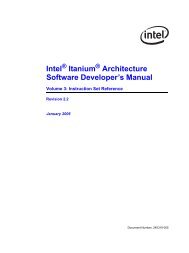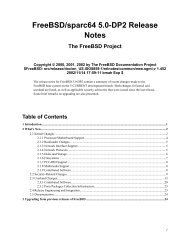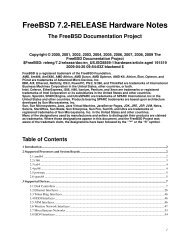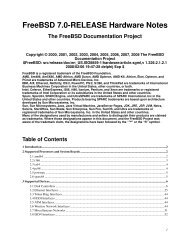- Page 1 and 2:
Sable CPU Module Specification This
- Page 3 and 4:
CONTENTS Preface ..................
- Page 5 and 6:
3.9.6 Data Cache Address Register (
- Page 7 and 8:
7.1.1 Exception Handling ..........
- Page 9 and 10:
11.4 Environmental Specifications -
- Page 11 and 12:
25 MM_CSR .........................
- Page 13 and 14:
27 Base Addresses for CSRs . . . ..
- Page 15 and 16:
Preface Scope and Organization of t
- Page 17 and 18:
Copyright © 1993 Digital Equipment
- Page 19 and 20:
CHAPTER 1 CPU MODULE COMPONENTS AND
- Page 21 and 22:
Copyright © 1993 Digital Equipment
- Page 23 and 24:
1.2 The Alpha AXP Architecture Copy
- Page 25 and 26:
Copyright © 1993 Digital Equipment
- Page 27 and 28:
Copyright © 1993 Digital Equipment
- Page 29 and 30:
Copyright © 1993 Digital Equipment
- Page 31 and 32:
Copyright © 1993 Digital Equipment
- Page 33 and 34: Copyright © 1993 Digital Equipment
- Page 35 and 36: Copyright © 1993 Digital Equipment
- Page 37 and 38: Copyright © 1993 Digital Equipment
- Page 39 and 40: Copyright © 1993 Digital Equipment
- Page 41 and 42: Copyright © 1993 Digital Equipment
- Page 43 and 44: Copyright © 1993 Digital Equipment
- Page 45 and 46: Copyright © 1993 Digital Equipment
- Page 47 and 48: Copyright © 1993 Digital Equipment
- Page 49 and 50: Copyright © 1993 Digital Equipment
- Page 51 and 52: Copyright © 1993 Digital Equipment
- Page 53 and 54: Copyright © 1993 Digital Equipment
- Page 55 and 56: Copyright © 1993 Digital Equipment
- Page 57 and 58: Copyright © 1993 Digital Equipment
- Page 59 and 60: Copyright © 1993 Digital Equipment
- Page 61 and 62: Copyright © 1993 Digital Equipment
- Page 63 and 64: Copyright © 1993 Digital Equipment
- Page 65 and 66: Copyright © 1993 Digital Equipment
- Page 67 and 68: Copyright © 1993 Digital Equipment
- Page 69 and 70: Copyright © 1993 Digital Equipment
- Page 71 and 72: Copyright © 1993 Digital Equipment
- Page 73 and 74: Copyright © 1993 Digital Equipment
- Page 75 and 76: Copyright © 1993 Digital Equipment
- Page 77 and 78: Copyright © 1993 Digital Equipment
- Page 79 and 80: Copyright © 1993 Digital Equipment
- Page 81 and 82: Copyright © 1993 Digital Equipment
- Page 83: Copyright © 1993 Digital Equipment
- Page 87 and 88: Copyright © 1993 Digital Equipment
- Page 89 and 90: Copyright © 1993 Digital Equipment
- Page 91 and 92: Copyright © 1993 Digital Equipment
- Page 93 and 94: Copyright © 1993 Digital Equipment
- Page 95 and 96: Copyright © 1993 Digital Equipment
- Page 97 and 98: Copyright © 1993 Digital Equipment
- Page 99 and 100: CHAPTER 4 FUNCTIONS LOCATED ELSEWHE
- Page 101 and 102: Copyright © 1993 Digital Equipment
- Page 103 and 104: Figure 41: B-Cache Control Register
- Page 105 and 106: Table 28 (Cont.): B-Cache Control R
- Page 107 and 108: Table 28 (Cont.): B-Cache Control R
- Page 109 and 110: Copyright © 1993 Digital Equipment
- Page 111 and 112: Copyright © 1993 Digital Equipment
- Page 113 and 114: Copyright © 1993 Digital Equipment
- Page 115 and 116: Copyright © 1993 Digital Equipment
- Page 117 and 118: Copyright © 1993 Digital Equipment
- Page 119 and 120: Copyright © 1993 Digital Equipment
- Page 121 and 122: 4.3.1 Duplicate Tag Error Register
- Page 123 and 124: 4.5 Lack of Cache Block Prefetch Co
- Page 125 and 126: Table 37: System-bus Control Regist
- Page 127 and 128: 4.7.2 System-bus Error Register - C
- Page 129 and 130: Table 38: System-bus Error Register
- Page 131 and 132: Table 38 (Cont.): System-bus Error
- Page 133 and 134: 4.7.3 System-bus Error Address Low
- Page 135 and 136:
Copyright © 1993 Digital Equipment
- Page 137 and 138:
4.8 Multiprocessor Configuration CS
- Page 139 and 140:
4.9 System Interrupt Clear Register
- Page 141 and 142:
4.10 Address Lock Register - CSR13
- Page 143 and 144:
4.11 Miss Address Register - CSR14
- Page 145 and 146:
Table 46 (Cont.): C4 Revision Regis
- Page 147 and 148:
Table 48 (Cont.): Interval Timer In
- Page 149 and 150:
Table 50: D-bus Microcontroller Clo
- Page 151 and 152:
Figure 58: Granting Order rule 4 CP
- Page 153 and 154:
Copyright © 1993 Digital Equipment
- Page 155 and 156:
Table 54 (Cont.): BIU_CTL Field Des
- Page 157 and 158:
Table 57: CPU EEPROM Defaults Locat
- Page 159 and 160:
Copyright © 1993 Digital Equipment
- Page 161 and 162:
Copyright © 1993 Digital Equipment
- Page 163 and 164:
Copyright © 1993 Digital Equipment
- Page 165 and 166:
Copyright © 1993 Digital Equipment
- Page 167 and 168:
Copyright © 1993 Digital Equipment
- Page 169 and 170:
Copyright © 1993 Digital Equipment
- Page 171 and 172:
Copyright © 1993 Digital Equipment
- Page 173 and 174:
Copyright © 1993 Digital Equipment
- Page 175 and 176:
Copyright © 1993 Digital Equipment
- Page 177 and 178:
Copyright © 1993 Digital Equipment
- Page 179 and 180:
Copyright © 1993 Digital Equipment
- Page 181 and 182:
Copyright © 1993 Digital Equipment
- Page 183 and 184:
Copyright © 1993 Digital Equipment
- Page 185 and 186:
Copyright © 1993 Digital Equipment
- Page 187 and 188:
Copyright © 1993 Digital Equipment
- Page 189 and 190:
Copyright © 1993 Digital Equipment
- Page 191 and 192:
Copyright © 1993 Digital Equipment
- Page 193 and 194:
Copyright © 1993 Digital Equipment
- Page 195 and 196:
Copyright © 1993 Digital Equipment
- Page 197 and 198:
Copyright © 1993 Digital Equipment
- Page 199 and 200:
Copyright © 1993 Digital Equipment
- Page 201 and 202:
Copyright © 1993 Digital Equipment
- Page 203 and 204:
Copyright © 1993 Digital Equipment
- Page 205 and 206:
Copyright © 1993 Digital Equipment
- Page 207 and 208:
Copyright © 1993 Digital Equipment
- Page 209 and 210:
Copyright © 1993 Digital Equipment
- Page 211 and 212:
CHAPTER 11 PHYSICAL AND ELECTRICAL
- Page 213 and 214:
Table 81 (Cont.): MCA240 J5 SIDE 1
- Page 215 and 216:
Table 82 (Cont.): MCA44 J1 Side 1 S
- Page 217 and 218:
11.3 CPU Module Max DC Power Requir
- Page 219 and 220:
Copyright © 1993 Digital Equipment
- Page 221 and 222:
Figure 68: module clocks Cobra - b
- Page 223 and 224:
Table 85 (Cont.): System bus AC and
- Page 225 and 226:
APPENDIX A ALPHA ARCHITECTURE OPTIO
- Page 227 and 228:
Copyright © 1993 Digital Equipment
- Page 229 and 230:
Copyright © 1993 Digital Equipment
- Page 231 and 232:
Copyright © 1993 Digital Equipment
- Page 233 and 234:
Copyright © 1993 Digital Equipment
- Page 235 and 236:
Copyright © 1993 Digital Equipment
- Page 237 and 238:
Copyright © 1993 Digital Equipment
- Page 239 and 240:
Copyright © 1993 Digital Equipment
- Page 241 and 242:
Copyright © 1993 Digital Equipment
- Page 243 and 244:
Copyright © 1993 Digital Equipment
- Page 245 and 246:
Copyright © 1993 Digital Equipment
- Page 247 and 248:
Copyright © 1993 Digital Equipment
- Page 249 and 250:
Copyright © 1993 Digital Equipment
- Page 251 and 252:
Copyright © 1993 Digital Equipment
- Page 253 and 254:
Copyright © 1993 Digital Equipment
- Page 255 and 256:
Copyright © 1993 Digital Equipment
- Page 257 and 258:
INDEX 21064 IEEE floating point con
- Page 259 and 260:
Icache, 59 ICCSR, 19 IEEE Floating
- Page 261:
STQC cycle, 144 STxC cycle, 144 STx




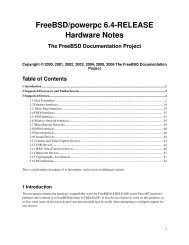

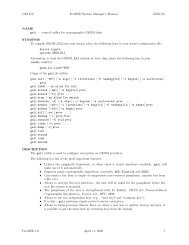
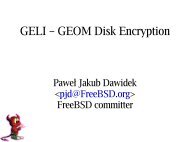
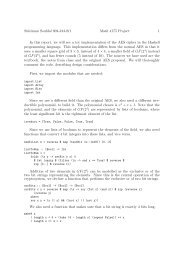
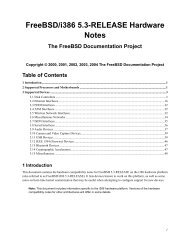


![Volume 3: Instruction Set Reference [pdf]](https://img.yumpu.com/5683779/1/190x252/volume-3-instruction-set-reference-pdf.jpg?quality=85)
